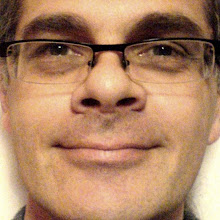I missed the afternoon concert of Plug, through at Stevenson College Edinburgh teaching, but got back through to Glasgow in good time for the electroacoustic concert; to be precise a concert of works for instrument plus live electronics and/or 'tape', as we still rather charmingly call prerecorded material.
It was a great gig. The first piece we heard was Mays' ('maze…') by Marek Pasieczny, which is by far the best work of Marek's I've ever heard. Very simple, just amplifed piano and 'tape'; starting off with the wonderfully refreshing sound of the amplified piano alone before introducing a prerecorded part made up of very similar piano material to that being played, sometimes just the same chord reversed. Quite jazzy in places; the title being an unfortunate pun on the name Lyle Mays, jazz pianist and composer, alluded to in the programme note. An excellent, captivating, bold, precise, glittering performance by Sylvia Sze-Hua Jen on piano.
David Jervis' Friction seemed to be for cello and laptop, although my guess is that effectively it was a 'tape' piece again, with the laptop there to give cues to the cellist. The piece was well-structured, with some quite loud and sharp gestures, which had the pleasant effect of pushing cellist Abigail Hayward in the direction of some almost vicious playing. A middle section used a kind of accelerating aleatoric mess of short water drop ish sounds, perhaps a bit of an ea cliché. It's a shame it couldn't have been played on an electric cello, or using a bug on the bridge; the cello was miked up but did not seem to entirely sit in the mix with the treated sounds.
Juliette Philogene's Colouring for 'tape' and clarinet had something of the same problem; the clarinet was not particularly closely miked and as a result was heard largely acoustically. This is not just a matter of loudness; rather a feeling that one wanted the instrument to really join in with the treated sounds, for the player to be in the same virtual world, right in the loudspeakers. The piece was given a characterful performance by saxist George Kastanos, moonlighting on clarinet in replacement for the indisposed Fraser A. M. Langton, for whom the piece had been written. The piece itself I found a bit confused, and it lost my attention for a while. And, a trill, of all things, on the clarinet, of all things, is not perhaps the best way to open a piece like this.
Flavia Casari's Dark shining light was a piece which had the same effect on me as several other people I spoke to afterwards; initial dislike followed by growing warmth. Part of this seemed to be down to this composer/performer's rather offputting stage manner. First of all, she didn't appear to have got it together to write the programme note in time for printing, leaving it to Alistair MacDonald to read out some back-of-an-envelope thoughts on her behalf. Then she wandered on stage, gave the most perfunctory nod to the audience imaginable, and carried on through the piece as though we weren't there, fumbling with her music, and generally looking as though she was a million miles away from anywhere exept giving a performance on stage.
Oddly enough, this kind of anti-stage presence really worked for this piece. The programme note read out was kind of cosmic, something about the background of the sky. The sounds of the piece fitted; a kind of background radiation of sustained, almost synthy sounds from the computer part, with sparse Henry Cowell/Olivier Messiaen-type gestures from the piano. Later in the piece we got what I think was the first instance of live transformation of the instrument in any of the pieces, with the piano played through what sounded suspiciously like a ring-modulator. Synthy? Ring modulator?! Sounds kind of tasteless, doesn't it? But it really, really worked.
Tim Cooper finished off the concert for us with his piece Switch 'for C trumpet, tape and live electronics' given an at-the-top-of-his-game performance by Tom Pouslon. Tim is a powerhouse of energy and enthusiasm at the academy, one of the wires the current goes through I think, and I've had the pleasure of working with him on a number of projects. His musical approach is kind of a million miles away from mine; a proper modernist, his music is all about, er, the music, the structure even. The 'tape' part here was made up of pre-recorded and treated fragments of Tom's playing, not entirely fixed it seemed but in places triggered by the performer, and with some transformation of the trumpet sound, some reverbs and delays, I think. Some touches of trumpet-player humour as well, for all my modernist slurs, with a tiny pre-recorded sound of Tom splitting a note poking slyly into the texture every once in a while. Oh, and for some unexplained reason the piece also seemed to feature the Shostakovich D-S-C-H motive (D Eb C B), which we left the concert whistling.
A great concert. There was a real feeling of engagement here, with all the performers either playing their own music or diffusing their own music or both, or teamed up with another performer with whom they had embarked together an sonic journey into the unkown. Mention must also go to Alistair MacDonald who in his wonderfully quiet and humourous way makes the electroacoustic wheels at the RSAMD go round. Yup, a very good concert indeed.
Thursday, 30 April 2009
Electroacoustic
Posted by J. Simon van der Walt at 08:37
Subscribe to:
Post Comments (Atom)

0 comments:
Post a Comment